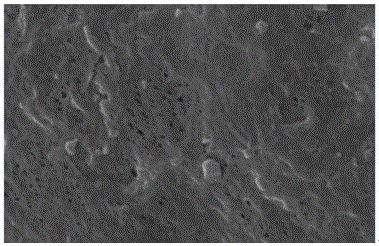Wound dressing and preparation method thereof
A wound dressing and product technology, applied in dressings, non-adhesive dressings, medical science and other directions, can solve the problems of lack of moisturizing function, easy dehydration of the wound surface and high permeability, so as to accelerate the proliferation of cells and keep the wound surface moist and uniform. good effect
- Summary
- Abstract
- Description
- Claims
- Application Information
AI Technical Summary
Problems solved by technology
Method used
Image
Examples
Embodiment 1
[0027] A preparation method of a silicone-nanofiber multilayer wound dressing, comprising the following steps:
[0028] (1) Prepare 15g of mixed solution with silicone prepolymer, liquid paraffin, n-hexane, and Span-80 according to the mass ratio of 25:3:70:2, and stir evenly. After vacuum defoaming, pour polytetrafluoroethylene In the vinyl mold, after uniform casting, vacuum drying at 50°C for 4 hours to obtain a silicone film; soak the silicone film in ethanol for 15 hours to remove the paraffin wax components in the silicone film, such as figure 2 As shown, a silicone membrane with a microporous structure is obtained;
[0029] (2) Dissolve PLA with Mw=90KDa in a mixed solvent of N,N-dimethylacetamide and acetone (1:1, v:v) with a mass fraction of 14%, heat to dissolve at 50°C, and let stand Degassing to obtain PLA electrospinning solution;
[0030] (3) Adhere the silicone film to the aluminum foil and fix it on the roller receiver of the electrospinning machine; load th...
Embodiment 2
[0033] A preparation method of a silicone-nanofiber multilayer wound dressing, comprising the following steps:
[0034] (1) Prepare 15g of mixed solution with silicone prepolymer, liquid paraffin, n-hexane, and Span-80 according to the mass ratio of 20:4:75:1, and stir evenly. After vacuum defoaming, pour polytetrafluoroethylene In the vinyl mold, after uniform casting, vacuum dry at 60°C for 3 hours to obtain a silicone film; soak the silicone film in ethanol for 24 hours to remove the paraffin wax component in the silicone film to obtain a silicone film with a microporous structure ;
[0035] (2) Dissolve PLGA with Mw=90KDa in a mixed solvent of chloroform and acetone (3:2, v:v) according to the mass fraction of 24%, heat and dissolve at 40°C, and let stand for defoaming to obtain PLGA electrospinning solution ;
[0036] (3) Adhere the silicone film to the aluminum foil and fix it on the roller receiver of the electrospinning machine; load the PLGA solution into the syring...
Embodiment 3
[0039] A preparation method of a silicone-nanofiber multilayer wound dressing, comprising the following steps:
[0040] (1) Prepare 20g of mixed solution with silicone prepolymer, liquid paraffin, n-hexane, and Span-80 according to the mass ratio of 22:1:74:3, and stir evenly. After vacuum defoaming, pour polytetrafluoroethylene In the vinyl mold, after uniform casting, vacuum dry at 45°C for 6 hours to obtain a silicone film; soak the silicone film in ethanol for 10 hours to remove the paraffin wax component in the silicone film to obtain a silicone film with a microporous structure ;
[0041] (2) Dissolve PCL with Mw=150KDa in a mixed solvent of glacial acetic acid and acetone (2:3, v:v) according to the mass fraction of 21%, heat and dissolve at 40°C, and let stand for defoaming to obtain PCL electrospun liquid;
[0042](3) Adhere the silicone film to the aluminum foil and fix it on the roller receiver of the electrospinning machine; load the PCL solution into the syringe...
PUM
 Login to View More
Login to View More Abstract
Description
Claims
Application Information
 Login to View More
Login to View More - R&D
- Intellectual Property
- Life Sciences
- Materials
- Tech Scout
- Unparalleled Data Quality
- Higher Quality Content
- 60% Fewer Hallucinations
Browse by: Latest US Patents, China's latest patents, Technical Efficacy Thesaurus, Application Domain, Technology Topic, Popular Technical Reports.
© 2025 PatSnap. All rights reserved.Legal|Privacy policy|Modern Slavery Act Transparency Statement|Sitemap|About US| Contact US: help@patsnap.com



